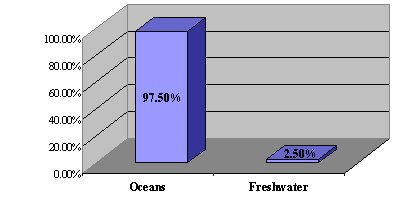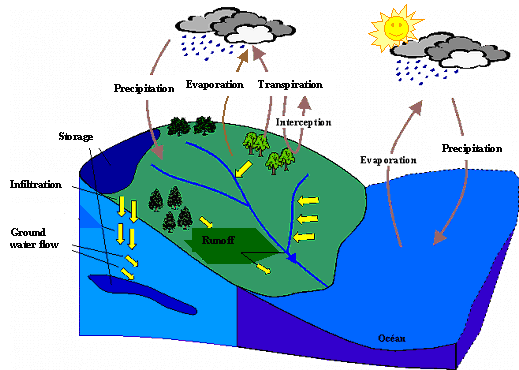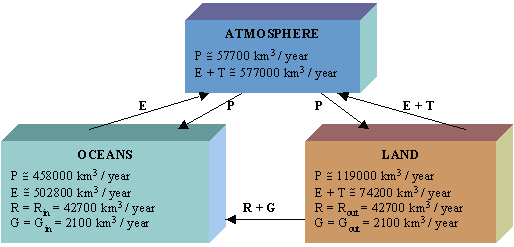
Water is vital for all living organisms on Earth. For centuries, people have been investigating where water comes from and where it goes, why some of it is salty and some is fresh, why sometimes there is not enough and sometimes too much. All questions and answers related to water have been grouped together into a discipline. The name of the discipline is hydrology and is formed by two Greek words: "hydro" and "logos" meaning "water" and "science". Hydrology is the science concerned with the occurrence, distribution, movement and properties of all the waters of the Earth.
A good understanding of the hydrologic processes is important for the assessment of the water resources, their management and conservation on global and regional scales.
The "Blue Planet", as the Earth is called, is easily identified in the solar system due to its distinctive element: water.
Oceans and seas cover 71% of the planet's surface. The remaining 29% are land, but water can be found here as well in lakes and rivers, in the soil cover, underground and bound up in the composition of minerals of the Earth's crust and core. The biosphere contains water and cannot exist without it. Water is held in the atmosphere together with other gases.
Water exists in three states: liquid, solid (ice and snow) and gas (water vapour). Due to the energy supplied by the sun it is in permanent transformation from one state to another, and in constant motion between oceans, land, atmosphere and biosphere.
A reliable assessment of the water storage on Earth considers the amount of water as an average over a long period of time, contained in the hydrosphere. Current estimations weigh up to 1386 million cubic kilometres of water that are divided as shown in Figure 1.1 and Table 1.1.

Figure 1.1. Distribution of water on Earth
Table 1.1. Distribution of freshwater on Earth
| Component of freshwater | % of the hydrosphere content |
| Glaciers and Permanent Snow Cover | 1.74 % |
| Groundwater | 0.75 % |
| Freshwater Lakes | 0.0066 % |
| Rivers | 0.0002 % |
| Atmosphere | 0.0009 % |
| Biosphere | 0.0001 % |
Freshwater is only 2.5% from the total, yet most of it is out of human reach. Freshwater usable by humans represents 0.3% of all water on Earth and is drawn from underground, lakes and rivers (Figure 1.2).

Figure 1.2. Freshwater available for human use (0.3 % of Earth's water)
Groundwater is the second largest storage of freshwater and the most used by humans. People in the arid and semi-arid regions, use groundwater exclusively for all their needs. Still, groundwater is not always within easy reach. The withdrawal of groundwater becomes difficult and expensive when it is confined over 800m depth.
The surface water bodies, as lakes and rivers, hold a very small amount of freshwater. Unlike groundwater it is easily accessible, but liable to pollution. At the same time, it is unevenly distributed with regard to continent surfaces and population. For example, 30 % of the world freshwater storage and 6 % of runoff are located in Canada alone.
The total amount of water on Earth is invariable. At the same time water is continuously renewed while circulating between oceans, land and atmosphere. All processes like evaporation, condensation, precipitation, interception, transpiration, infiltration, storage, runoff, groundwater flow, which keep water in motion constitute the hydrologic cycle. Those processes are stimulated by solar energy. They take place simultaneously and, except for precipitation, continuously. Consider Figure 1.3.

Figure 1.3. The hydrologic cycle (Musy, 2001)
Water from rivers is replenished every year. Simultaneously the quality of water is restored. The assessment of water resources availability or deficiency for a specific region is based on the volume of runoff in that region. The water volume of each water body in the hydrosphere is fully replenished during the hydrologic cycle, but the time period required varies as is shown in Table 1.2.
Table 1.2. Period of renewal of water in the hydrosphere (UNESCO, 2004)
| Water body | Period of renewal |
| Polar ice | 9700 years |
| Oceans | 2500 years |
| Mountain glaciers | 1600 years |
| Groundwater | 1400 years |
| Lakes | 17 years |
| Rivers | 16 days |
| Atmospheric moisture | 8 days |
| Water in the biosphere | Several hours |
Water from rivers is completely renewed every year. Simultaneously its quality is restored.
The water budget represents the inventory of water for a specific water body (or hydrologic region) during a certain time interval.
It can be estimated using the continuity equation, which expresses the balance between the inflows, outflows and change of storage in any water body / hydrologic region over a period of time:
P - R - G - E - T = ΔS |
(1.1) |
| where: | ||
| P | precipitation, [unit of height] or [unit of volume / unit of time] | |
| R | runoff, [unit of height] or [unit of volume / unit of time] | |
| R = Rout - Rin | ||
| Rout = runoff as outflow from the water body / hydrologic region | ||
| Rin = runoff as influx into the water body / hydrologic region | ||
| G | groundwater flow, [unit of height] or [unit of volume / unit of time] | |
| G = Gout - Gin | ||
| Gout = groundwater as outflow from the water body / hydrologic region | ||
| Gin = groundwater as influx into the water body / hydrologic region | ||
| E | evaporation, [unit of height] or [unit of volume / unit of time] | |
| T | transpiration, [unit of height] or [unit of volume / unit of time] | |
| ΔS | change in storage, [unit of height] or [unit of volume / unit of time] | |
Equation 1.1 is the basic equation of hydrology. In practice it is successfully applied for local studies when the various hydrologic terms can be properly measured or estimated. Nevertheless estimation is usually rough on a global scale.
Every year approximately 577'000 km3 are transported through the hydrosphere. The annual water budget is displayed on Figure 1.4.

Figure 1.4. Annual water budget of the Earth
Table 1.3. Annual water budget of Switzerland (Musy, 2001)
| Precipitation | 1546 mm / year | ||
| Total runoff | Runoff | 978 mm / year | 1296 mm / year |
| Influx into Switzerland | 318 mm / year | ||
| evaporation | 484 mm / year | ||
Table 1.4. Annual water budget of Romania (National Institute
of Meteorology and Hydrology, Regional Office, Timisoara)
| Precipitation | 850 mm / year |
| Runoff | 300 mm / year |
| evaporation | 550 mm / year |
Table 1.5. Annual water budget of Bulgaria (Geography of
Bulgaria,
monograph, Bulgarian Academy of Sciences , 1989)
| Precipitation | 690 mm / year |
| Runoff | 176 mm / year |
| evaporation | 514 mm / year |
Table 1.6. Annual water budget of Ukraine
| Precipitation | 625 mm / year |
| Runoff | 86.8 mm / year |
| evaporation | 538 mm / year |
In ancient times various hydrologic principles were successfully applied in practice. Early Chinese irrigation and flood control works and Greek and Roman aqueducts are worth mentioning. On the other hand ancient science was based only on logic and intuition, without measurements and observations, and the theories were faulty most of the time.
Homer (8th century B.C.) believed in the existence of large subterranean reservoirs that supplied rivers, seas, springs and wells. The Roman engineer Marcus Vitruvius (1st century B.C.) developed an early theory of the hydrologic cycle in his treatise 'On Architecture'. According to his theory the rain and snow falling in mountains infiltrated into the ground and later appeared in the lowland as streams and springs. During the Middle Ages, Vitruvius's work was the standard reference book on Hydrology.
In the late 15th century Leonardo da Vinci and Bernard Palissy gave, independently of each other, an accurate explanation of the hydrologic cycle. The theories were based on observations of hydrologic phenomena. In the 17th century the modern science of hydrology was established by Perrault, Mariotte and Halley. Perrault measured the rainfall and runoff in the Seine River and proved that rainfall contributes significantly to river flow. He also measured evaporation and capillarity. Mariotte recorded the velocity of flow in the Seine River and made measurements of the cross section, estimating the discharge. Halley measured evaporation of the Mediterranean Sea.
The Bernoulli piezometer and theorem, the Pitot tube and Chezy's formula are representative achievements of the 18th century. During 19th century experimental hydrology made considerable progress: Darcy's law of flow in porous media and Dupuit-Thiem's well formula were elaborated.
Early 20th-century governmental agencies developed their own programs of hydrologic research. Sherman's unit hydrograph, Horton's infiltration theory and Theis's non-equilibrium approach to well hydraulics were based on their analyses and were the results of research programs. After 1950 the progress in sciences and the high-speed digital computers opened new perspectives in hydrology.
Bibliography
Musy, A. 1998. Hydrologie appliquée, Cours polycopié d'hydrologie générale, Lausanne, Suisse.
Musy, A. 2001. e-drologie. Ecole Polytechnique Fédérale, Lausanne, Suisse.